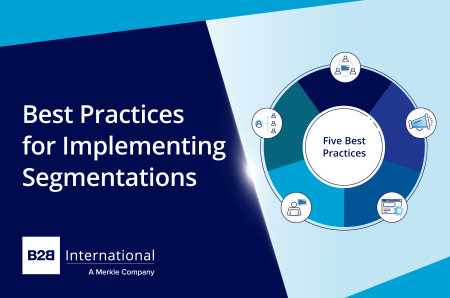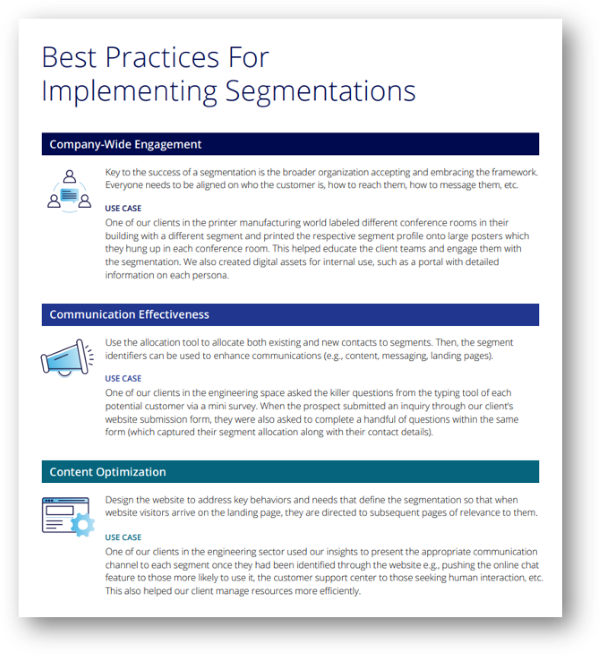
Having researched hundreds of B2B brands over the years, we know how to support our clients in achieving successful segmentation outcomes. To help you apply segmentations more effectively, below are 5 optimal applications and use cases for implementing segmentations:
Company-Wide Engagement
Key to the success of a segmentation is the broader organization accepting and embracing the framework. Everyone needs to be aligned on who the customer is, how to reach them, how to message to them, etc.
Use-Cases
One of our clients in the printer manufacturing world labeled different conference rooms in their building with a different segment and printed the respective segment profile onto large posters which they hung up in each conference room. This helped educate the client teams and engage them with the segmentation. We also created digital assets for internal use, such as a portal with detailed information on each buyer persona.
Communication Effectiveness
Use the allocation tool to allocate both existing and new contacts to segments. Then, the segment identifiers can be used to enhance communications (e.g., content, messaging, landing pages).
Use-Cases
One of our clients in the engineering space asked the killer questions from the typing tool of each potential customer via a mini survey. When the prospect submitted an inquiry through our client’s website submission form, they were also asked to complete a handful of questions within the same form (which captured their segment allocation along with their contact details).
Content Optimization
Design the website to address key behaviors and needs that define the segmentation so that when website visitors arrive on the landing page, they are directed to subsequent pages of relevance to them.
Use-Cases
One of our clients in the engineering sector used our insights to present the appropriate communication channel to each segment once they had been identified through the website e.g., pushing the online chat feature to those more likely to use it, the customer support center to those seeking human interaction, etc. This also helped our client manage resources more efficiently.
Sales Enablement
Empower sales teams by helping them use the segmentation to transition from a product-first to a customer-first focus. A deeper understanding of how customers differ across the key segment characteristics makes sales teams more empathetic to customer needs and pain points, enabling them to talk value over price.
Use-Cases
One of our clients in facility management services installed the killer questions behind the allocation tool onto the sales teams’ iPads so that when they visited prospective customers, they would run through the questions to identify the customer’s segment and then present the appropriate products/solutions with more effective messaging.
Channel Partner Integration
Consider opportunities to incorporate the segmentation with channel partners to improve reach to a qualified audience. This can work well in the case of exclusive distributor partnerships, as well as third party tools.
Use-Cases
One of our clients in the financial services sector integrated the segmentation into third party marketing databases for reaching wider audiences while maintaining the predictive accuracy from the typing tool.
Readers of this article also viewed:
- Understanding Behaviors, Motivations and Intent Is the Missing Piece of the Segmentation Puzzle
- The 4 Key Traits of Effective Buyer Segmentation
- A Practical 10-Step Guide to Market Segmentation
- Market Segmentation in B2B Markets
- How to Research, Develop and Activate Buyer Personas in B2B



